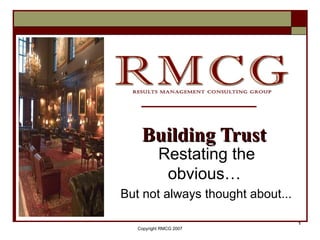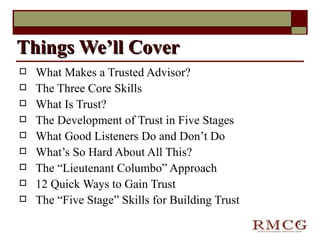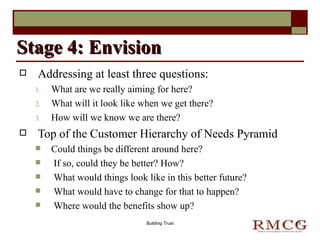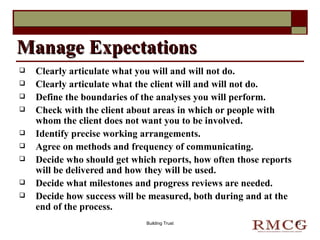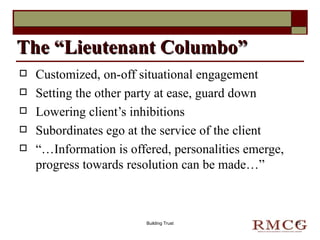Building Trust
- 1. Restating the obvious… But not always thought about... Building Trust Copyright RMCG 2007
- 2. What Makes a Trusted Advisor? The Three Core Skills What Is Trust? The Development of Trust in Five Stages What Good Listeners Do and Don’t Do What’s So Hard About All This? The “Lieutenant Columbo” Approach 12 Quick Ways to Gain Trust The “Five Stage” Skills for Building Trust Things We’ll Cover
- 3. A common trait of trusted advisor relationships is that the advisor places a higher value on maintaining and preserving the relationship itself than on the outcome of the current transaction. The advisor makes a substantial investment in the client, without guarantee of return, before the relationship generates any benefit, any income, let alone any profit. What Makes a Trusted Advisor?
- 4. The Three Core Skills The Ability to Earn Trust The Ability to Give Advice The Ability to Build Relationships TEXT EARN GIVE BUILD
- 5. Trust must be both earned and deserved. You must do something to give people evidence that helps them decide whether to trust you. You must be willing to give in order to receive. People tend to trust one another if they are convinced the other is in for the long haul and not looking simply to maximize the short-term benefit of individual interactions. Provide some evidence that my interests are as important to you as yours are. Earning Trust Building Trust
- 6. Advice is not an exclusively logical process, but rather an emotional duet played between the advisor and client. Think about the personal risks (reputation, promotion opportunities, career issues). Consider the sensitivities, emotions and politics of the client engagement. Take away their worries and absorb all their hassles. Provide reassurance, calm their fears and inspire confidence. Giving Advice Building Trust
- 7. Find the Right Words Ask the Right Questions Be Mindful of Politics Find the Right Time Advising Skills Building Trust
- 8. Go First Show, Don’t Just Tell Be Sure Your Advice Is Being Sought Earn the Right to Offer Advice Say What You Mean Building Relationships Building Trust
- 9. Trust Grows Trust is Both Rational and Emotional Trust is a Two Way Relationship Trust Entails Risk Trusting is Prerequisite Trust is Personal What is Trust? Building Trust
- 10. The Development of Trust in Five Stages Building Trust Engage Envision Listen Frame Commit Stage 1 Stage 2 Stage 3 Stage 4 Stage 5 LISTEN FRAME ENGAGE ENVISION COMMIT
- 11. Engaging requires the skill of being credibly noticed. Listening requires the ability to understand another human being. Framing requires creative insight and emotional courage. Envisioning requires a spirit of collaboration and creativity. Commitment requires the ability to generate enthusiasm and manage over-enthusiasm . “ Five Stage” Skills Building Trust
- 12. Connection An initial connection between the advisor and client that sets the stage for the client to want to discuss his or her need. Investment An investment in time and energy to take a risk on the would-be advisor (something the client would not do unless they see some likelihood of good results in return). Specificity Not even your current clients will respond to you just because you listen; they must believe that you have something to offer them on a specific issue in order to open up to you about it. Stage 1: Engage Building Trust
- 13. Building Trust Forces of Communication Comprehension Specifics Incompre - hension Level 3 Action Credibility Hostility Level 5 Awareness Level 2 Impact Unawareness Forgetful -ness Level 1 Barriers to Communication Conviction Relevance Apathy Level 4
- 14. Advisors make two common mistakes when listening to earn the right: Overly rational listening Overly passive listening At the end of the day, you want the client to be able to look you in the eye and know that you won’t let things go by that aren’t in his or her right interest. Stage 2: Listen Building Trust
- 15. They probe for clarification. They listen for a story, and for unvoiced emotions. They empathize. They summarize well. They get rid of distractions while listening. They keep the client talking by asking for more details that help them understand. They look (not stare) at the client as the client speaks. They encourage by nodding their head or giving a slight smile. They ask how they might be of help. What Good Listeners Do Building Trust
- 16. Interrupt. Respond too soon. Editorialize in midstream. Jump to conclusions. Judge the speaker. Try to solve the problem too quickly. Take calls or interruptions in the course of a meeting. They are aware of and control their body movement (they don’t move around, shake their legs, fidget with objects) What Good Listeners Don’t Do Building Trust
- 17. Rational Framing – identify the variables generating a list, drawing a diagram or sketching out a process or approach Emotional Framing – emotional or political “ Naming & Claiming” Acknowledgment of the difficulty of raising the issue Acceptance of responsibility for raising it; and A direct statement of the issue itself. Ensure Blame-Free Problem Statements Stage 3: Frame (cont.) Building Trust
- 18. Do make judicious use of responsibility-taking caveats like: “ It’s probably just me, but ...” “ I’m sure you’ve covered this before, but ...” “ You’ve probably thought of this already, but ...” “ I’m not sure if this is on point, but ...” More on Emotional Framing Building Trust
- 19. Addressing at least three questions: What are we really aiming for here? What will it look like when we get there? How will we know we are there? Top of the Customer Hierarchy of Needs Pyramid Could things be different around here? If so, could they be better? How? What would things look like in this better future? What would have to change for that to happen? Where would the benefits show up? Stage 4: Envision Building Trust
- 20. The dictionary gives two meanings of the word commitment: An agreement or pledge to do something in the future ; and The state or instance of being obligated or emotionally impelled . 1) = Action 2) = Emotional State Stage 5: Commit Building Trust
- 21. We strive to Limit our commitments to the extent necessary to meet ALL of them! I f you follow the trust-building process, by the time you get to Stage 5, the problem has been framed to everyone’s satisfaction, and the vision you wish to attain is clear. What must follow is a series of conversations that will prioritize and limit commitments… Limiting Commitments Building Trust
- 22. What stands in the way of achieving the solution? What the involved parties are willing to do about it? Who must be brought into the loop? What roles each person must play? What information you need? When and how to check in on progress? What key deadlines loom ahead? What are the Risks or Pitfalls? Before Committing – Converse Building Trust
- 23. Clearly articulate what you will and will not do. Clearly articulate what the client will and will not do. Define the boundaries of the analyses you will perform. Check with the client about areas in which or people with whom the client does not want you to be involved. Identify precise working arrangements. Agree on methods and frequency of communicating. Decide who should get which reports, how often those reports will be delivered and how they will be used. Decide what milestones and progress reviews are needed. Decide how success will be measured, both during and at the end of the process. Manage Expectations Building Trust
- 24. “ It’s all too personally risky.” Risk is the essence of creating intimacy. “ Content is Everything.” It means very little if the client doesn’t trust you. “ The process sounds so s-l-o-w! My budget won’t allow for this!” Perceived value on the client’s part Doesn’t have to be recouped on this one What’s so hard about all this? Building Trust
- 25. Customized, on-off situational engagement Setting the other party at ease, guard down Lowering client’s inhibitions Subordinates ego at the service of the client “… Information is offered, personalities emerge, progress towards resolution can be made…” The “Lieutenant Columbo” Building Trust
- 26. 1. Listen to everything. 2. Empathize (for real). 3. Note what the client is feeling. 4. Build a shared agenda. 5. Take a point of view. 6. Take a personal risk. 7. Ask about a related area. 12 Quick Ways to Gain Trust Building Trust
- 27. 8. Ask great questions. 9. Give away ideas. 10. Return calls with unbelievable speed. 11. Relax your mind. Concentrate on a piece of wisdom or key question like: It’s about the client. Who am I thinking about? The problem is rarely what the client said it was. 12. Don’t miss a commitment! 12 Quick Ways to Gain Trust Building Trust
Editor's Notes
- Do you ever find yourself asking one or more of the following questions: * How can I get access to my clients more often? * How can I cross-sell or up-sell more? * How can I avoid being typecast, labeled as a specialist only in my main discipline? * How do I get clients less focused on price? * How do I get clients to play fairly with me? The answers to these and other similar questions have the same basis — you must earn your client’s trust; without trust, none of these ambitions can be realized.
